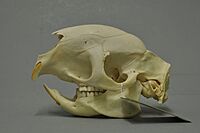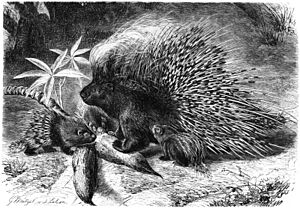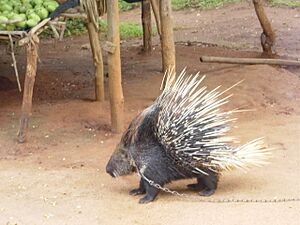Crested porcupine facts for kids
Quick facts for kids Crested porcupine |
|
|---|---|
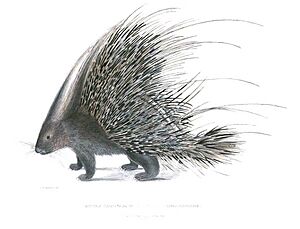 |
|
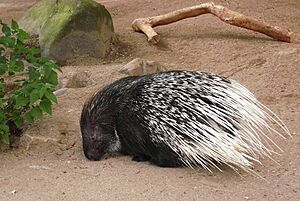 |
|
| Crested porcupine in captivity | |
| Conservation status | |
| Scientific classification | |
| Genus: |
Hystrix
|
| Species: |
cristata
|
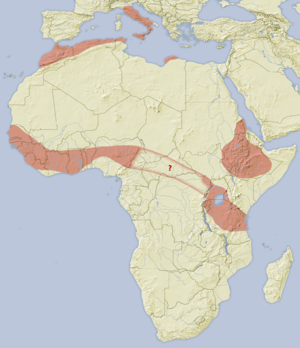 |
|
| range | |
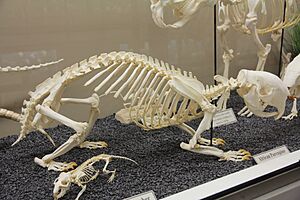
The crested porcupine (Hystrix cristata), also known as the African crested porcupine, is a large rodent found in Italy, North Africa, and sub-Saharan Africa. It's known for its unique quills and nocturnal habits.
Contents
Amazing Features
Crested porcupines are quite big! They can be about 60 to 83 centimeters (2 to 2.7 feet) long, not counting their tail. They usually weigh between 13 and 27 kilograms (28 to 60 pounds). This makes them one of the largest rodents in the world.
Their bodies are covered in coarse, dark brown or black bristles. What makes them special are their quills. These quills run along their head, neck, and back. They can raise these quills to form a crest, which is how they got their name.
Some of their quills are very strong and can be about 35 centimeters (14 inches) long. These longer quills are mostly for defense. They have light and dark bands and are not firmly attached. This means they can come off easily if needed.
The porcupine also has a short tail with special "rattle quills" at the end. These quills are hollow and have thin walls. When the porcupine shakes them, they make a hissing rattle sound. This sound helps warn off danger.
Crested porcupines can live for a very long time, up to 28 years! This is one of the longest lifespans for any rodent.
Where They Live
You can find crested porcupines in many places. In the Mediterranean region, they live in mainland Italy and the island of Sicily. They are also found in countries like Morocco, Algeria, and Tunisia.
In Africa, they live across a wide area. This includes countries like Ghana, Libya, and along the Egyptian coast. They can live from sea level up to high mountains, like 2,550 meters (8,366 feet) in Morocco.
They are native to many African countries, including Benin, Burkina Faso, Cameroon, Chad, Ethiopia, Kenya, Mali, Nigeria, Senegal, Somalia, Sudan, Tanzania, and Uganda.
How They Live
Crested porcupines spend most of their time on the ground. They don't often climb trees, but they are good swimmers. They are nocturnal, which means they are active at night. During the day, they rest in burrows or caves.
These porcupines are usually monogamous, meaning a male and female pair stay together. They also take care of their young for a long time. Small family groups often include the adult pair and their young of different ages.
Defense Strategies
When a crested porcupine feels threatened, it has some clever ways to defend itself. First, it will raise and fan out its quills. This makes the porcupine look much bigger and more intimidating.
If the danger continues, the porcupine will stamp its feet and make its quills whirr. Then, it might charge backward at the enemy. It tries to stab the attacker with its thicker, shorter quills. These powerful attacks have been known to scare off or even injure large predators like lions, leopards, and hyenas. They can even injure humans if provoked.
Crested porcupines also have a strange habit: they collect bones! They are mostly active at night and might find animal skeletons. They gather these bones and store them in underground chambers or caves.
What They Eat
Crested porcupines are mostly herbivores, meaning they eat plants. Their diet includes roots, bulbs, and leaves. However, they sometimes eat insects, small animals, and even dead animals (carrion).
They also like to gnaw on bones. This helps them get important calcium for their bodies. It also helps keep their front teeth sharp. These animals often travel long distances at night to find food.
Their teeth are designed to grind plant material. This food is digested in their stomach. Any parts that aren't digested go into a special part of their large intestine. Here, tiny living things (microorganisms) help break down the tough plant fibers.
Family Life
Most of what we know about crested porcupine reproduction comes from watching them in zoos. Female porcupines usually have one litter of babies each year.
After about 66 days of gestation (pregnancy), one or two well-developed young are born. They are born in a special chamber inside the burrow, often lined with grass. Newborn porcupines weigh about 1,000 grams (2.2 pounds). This is about 5% of their mother's weight.
The young porcupines leave the den after about one week. At this time, their soft spines start to harden. They reach their adult weight when they are one to two years old. They can also start having their own babies around this time. In the wild, they can breed throughout the year.
Local Names
Here are some other names for the crested porcupine in different languages:
- In Italian: porcospino or istrice
- In the Tigrinya language: ቅንፈዝ (qinfiz)
- In Amharic: jart
- In the Akan language: kotoko
- In the Oromo language: xadddee
- In Spanish: puercoespín
Images for kids



